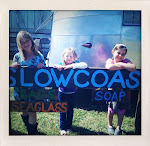slow, adj. def. moving a short space in a relatively long time; not swift; not quick in motion; not rapid; moderate; deliberate; gradual; as, a slow stream; a slow motion; as, the slow growth of arts and sciences.
I've started calling the place I live The Slow Coast.
Some people call it the North Coast, since it's north of Santa Cruz. To some, it's the central coast of California. My town, Davenport, is at the very mid-point of the California coast.
But technically the Central Coast of California spans Santa Cruz Co. south to Santa Barbara/north Ventura. With all due respect, that just doesn't cut it as a name for here.
"The Slow Coast" is a better name.
It’s not just because things are mellower here compared to the supersonic pace of Silicon Valley just over the mountains, the busy coast up north of us in San Francisco or southern California’s “Fast Coast”.
The stretch of coast and mountains from Wilder Ranch to north of San Gregorio is beautiful, quiet, productive and mostly devoid of people and major highways. A bit inland you'll find slow-growing redwoods, meandering creeks, slow-crawling newts and the slowest of all: banana slugs.
Farms and ranches produce luscious organic strawberries, apples, wine, cheese and pie.
Here the fog pushes up between the trees, then gives way to sun. Waves travel slowly across the Pacific to meet the land, at the bottom of a steep trail. Salmon and steelhead push upstream. Grey whales hug the shoreline on their annual migration between Alaska and Baja California.
A few months ago I walked the coast from Santa Cruz up to San Francisco to attend Slow Food Nation, a massive gathering of farmers, growers, ranchers, producers of wine, beer, honey--you name it--people who produce food in traditional, organic ways. It took four days and I took my own sweet time. Few people take long treks up our coast, so I was alone with the sea to my left most of the time.
A slow walk on the Slow Coast.
Come visit The Slow Coast. There are a few wonderful places to lodge, camp or hostel. Take some time to walk the trails and beaches, watch the newts and slugs, the hawks and herons, the bobcats and deer, and pick some berries and apples. And be sure to eat some pie. Lots ofpie!
It’s not just Slow Food and leisure walks, aimlessly exploring back roads, lighthouses and watching wildlife. We have great surf, tough hiking and excellent biking trails. Places called Bear Gulch, Pigeon Point, Gazos Creek, Waddell Beach.
The Slow Coast is an antidote to your fast life. A place that you know will be there, more or less the same. Even when you aren’t.
[Bring along a copy of Carl Honore’s book, In Praise of Slowness: Challenging the Cult of Speed]
Take it easy. Keep it slow.
*The place we call the The Slow Coast encompasses the beaches and coastal range from roughly just north of Santa Cruz to just south of Half Moon Bay, including the communities of Bonny Doon, Davenport, Ano Nuevo, San Gregorio, and Pescadero.
Some of the folks making a living on the Slow Coast and waiting for you to stop by are listed in the links to the right.
By the way, our efforts to highlight our Slow Coast community parallel other Slow Coasts around the world, such as those in the UK and Canada. We hope to visit them, and to enjoy their coast, and to someday return the favor.
-Wallace J. Nichols









